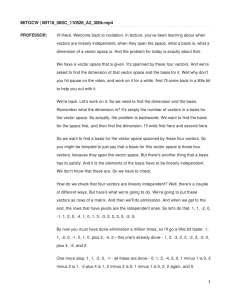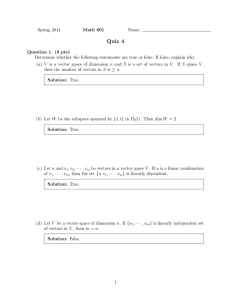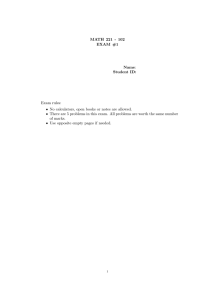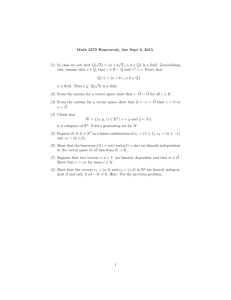18.06 Linear Algebra, Fall 2011 Recitation Transcript – Basis and Dimension
advertisement
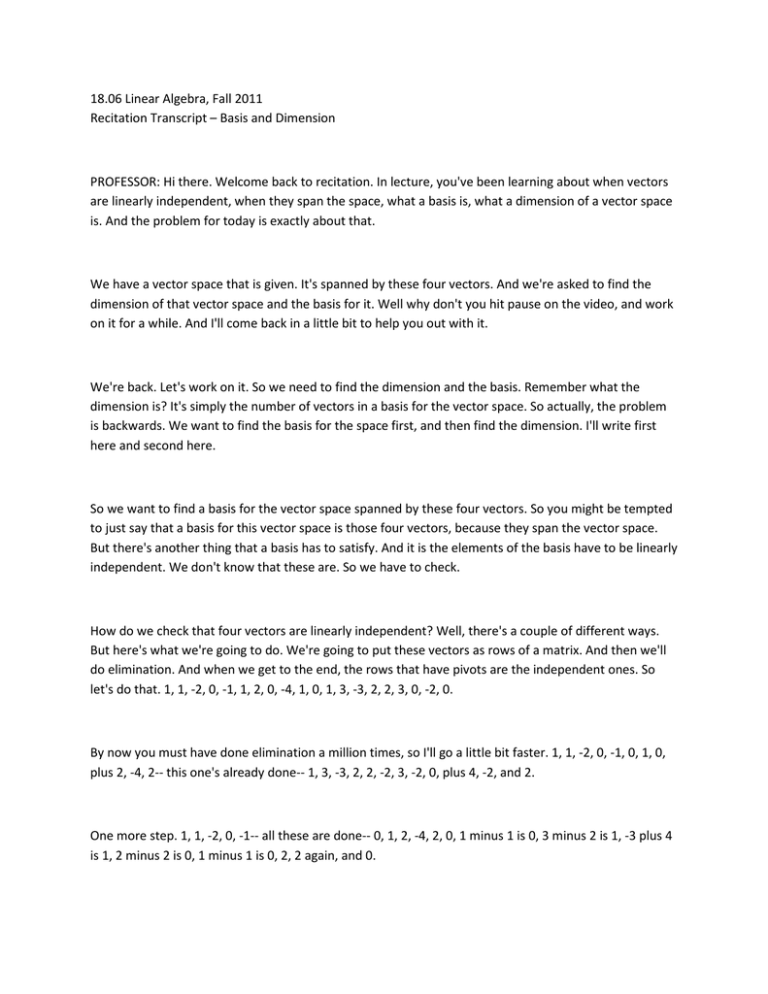
18.06 Linear Algebra, Fall 2011 Recitation Transcript – Basis and Dimension PROFESSOR: Hi there. Welcome back to recitation. In lecture, you've been learning about when vectors are linearly independent, when they span the space, what a basis is, what a dimension of a vector space is. And the problem for today is exactly about that. We have a vector space that is given. It's spanned by these four vectors. And we're asked to find the dimension of that vector space and the basis for it. Well why don't you hit pause on the video, and work on it for a while. And I'll come back in a little bit to help you out with it. We're back. Let's work on it. So we need to find the dimension and the basis. Remember what the dimension is? It's simply the number of vectors in a basis for the vector space. So actually, the problem is backwards. We want to find the basis for the space first, and then find the dimension. I'll write first here and second here. So we want to find a basis for the vector space spanned by these four vectors. So you might be tempted to just say that a basis for this vector space is those four vectors, because they span the vector space. But there's another thing that a basis has to satisfy. And it is the elements of the basis have to be linearly independent. We don't know that these are. So we have to check. How do we check that four vectors are linearly independent? Well, there's a couple of different ways. But here's what we're going to do. We're going to put these vectors as rows of a matrix. And then we'll do elimination. And when we get to the end, the rows that have pivots are the independent ones. So let's do that. 1, 1, -2, 0, -1, 1, 2, 0, -4, 1, 0, 1, 3, -3, 2, 2, 3, 0, -2, 0. By now you must have done elimination a million times, so I'll go a little bit faster. 1, 1, -2, 0, -1, 0, 1, 0, plus 2, -4, 2-- this one's already done-- 1, 3, -3, 2, 2, -2, 3, -2, 0, plus 4, -2, and 2. One more step. 1, 1, -2, 0, -1-- all these are done-- 0, 1, 2, -4, 2, 0, 1 minus 1 is 0, 3 minus 2 is 1, -3 plus 4 is 1, 2 minus 2 is 0, 1 minus 1 is 0, 2, 2 again, and 0. Well, you can see where this is going. In the next step, this row is going to disappear. 1, 1, -2, 2, 0, -1, 0, 1, 2, -4, 2, 0, 0, 1, 1, 0, 0, 0, 0, 0, 0. All right. We're done with elimination. So let's circle our pivots. All right, here are our pivots. We have three pivots. And so these three rows are linearly independent. And in fact, these rows still span the same space that the initial four rows did. Because when you do elimination, all that you're doing is recombining your rows by doing linear combinations of them. So, for example, your first row stayed the same throughout. Your second row was replaced by row 2 minus row 1. But it's really still spanning the same space. And it goes on. And then the fourth row, it turns out, was useless. You only needed the first three. So the elements for a basis-- well, it will be these three. So let me write that. Basis (1, 1, -2, 0, -1), 2, 2 and 0, 0, 1, 1, 0. Could you have used the first three rows? Yes, you could. You can't always do that. Sometimes in elimination, you have to switch rows, because there's a 0 where a pivot should be. When that happens, you have to use these three, or you have to keep track of which row you switched to go back and use the initial ones. But it's really safe to use these ones. And also they're simpler than the ones that you started with, so why not? The other question that we had was what is the dimension of the vector space? Well, this is the easy part. The dimension of the vector space is 1, 2, 3. And that solves the problem. But there's one more thing that I want to tell you. I told you that there's a couple of ways to find out which of those four vectors are linearly independent. And the one that I used was I put them into rows and performed elimination and picked out the rows that have pivots on them. Another way to do it is to write the initial vectors as columns of the matrix and then perform elimination. That also works and, as you know, because you're only working with the transpose of this matrix, you get the same number of pivots. Let's go over here where I have the same-- well, the transpose of that matrix-- I have the same vectors, but now written as columns. My four initial vectors written as columns. And here I have performed elimination. And this is the final result. Let me circle the pivots again. Here they are, three, which is going to give me three linearly independent vectors and hence, three elements of the basis, and hence, dimension 3 for the vector space. But I could no longer use these three columns as elements of the basis, because when I did elimination, I changed the column space. So the column space of this vector-- of this matrix is not the same as the column space of the eliminated version. So I cannot use these. In fact, if you look at them, you can probably understand that they're not going to span the same space as these. Because all that I have down here are 0s, and I get a lot more than just 0s in the last two entries of the vectors. So what I need to do is-- the pivots are in the first, second, and third columns. I need to use these three columns as my basis. I'll just write basis down here. And that will work too. So see, I have produced two different bases for the same vector space, which is totally fine. You can pick the basis that you prefer. All right. We're done. Thank you. MIT OpenCourseWare http://ocw.mit.edu 18.06SC Linear Algebra Fall 2011 For information about citing these materials or our Terms of Use, visit: http://ocw.mit.edu/terms.
